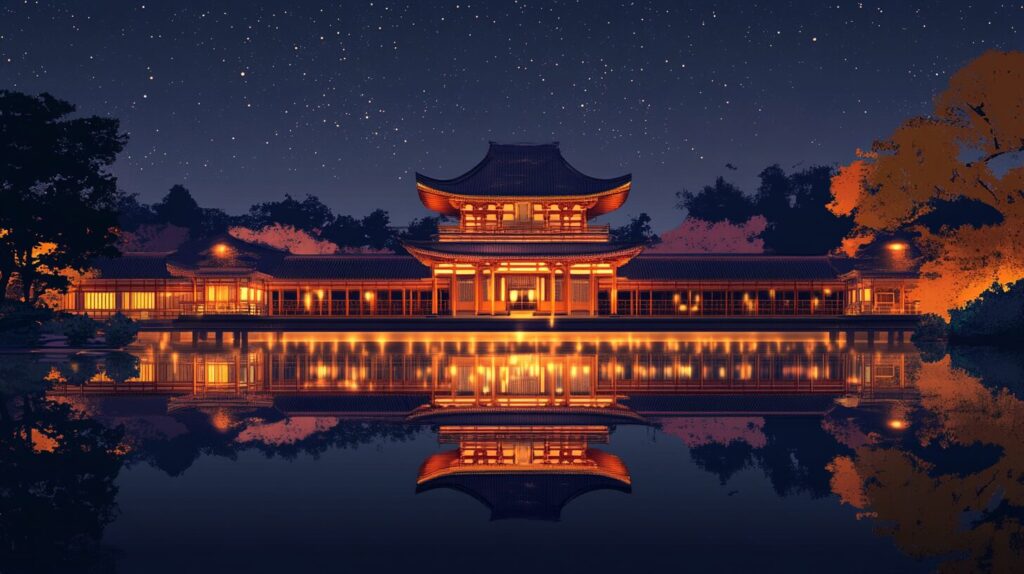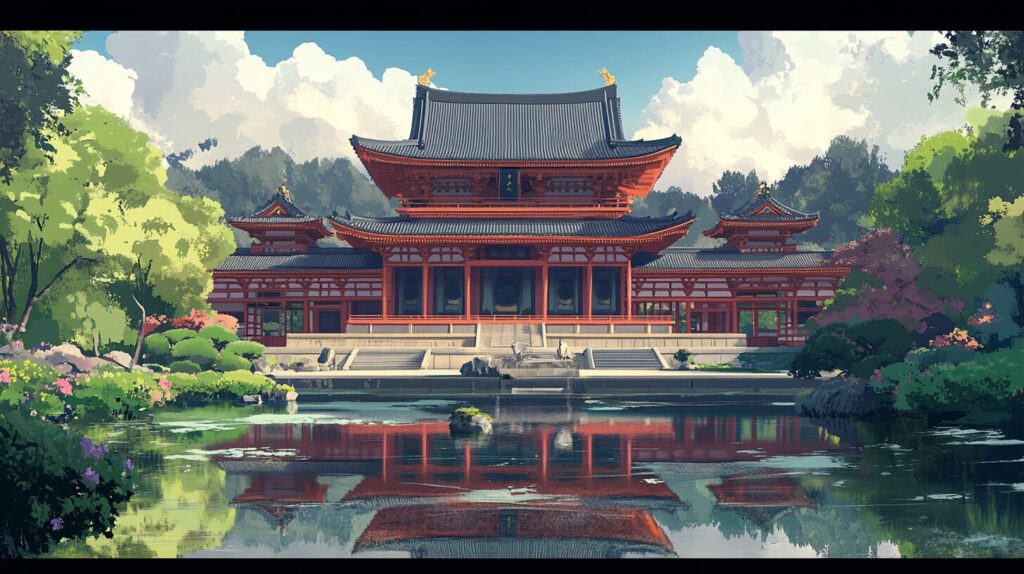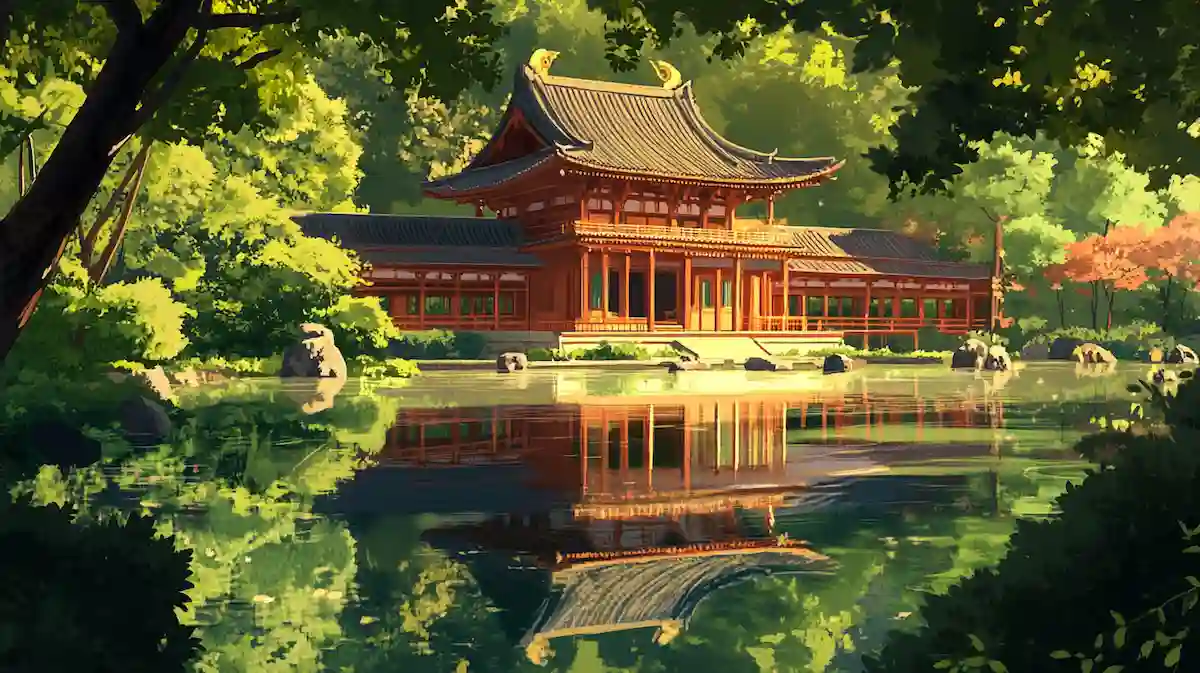平等院鳳凰堂を英語で説明・紹介するための基本情報と、英会話に役立つ表現をシンプルでわかりやすい英語で紹介します。
英会話ダイアローグ・関連情報・10の質問を通して、平等院鳳凰堂に関する英語表現を学びます。
英語
英会話ダイアローグを読む前に知っておくと良い前提知識と情報です。
- 平等院鳳凰堂の歴史
- 平等院は平安時代に藤原道長の別荘として建てられた
- 1052年に藤原頼通が仏教寺院に改めた
- 平等院の中心的な建築物の鳳凰堂は1053年に完成
- 鳳凰堂の特徴と魅力
- デザイン: 鳳凰が翼を広げた姿を模した優雅な建築、屋根には一対の鳳凰像がある
- 内部の仏像: 阿弥陀如来坐像(国宝)が安置され、壁には52体の雲中供養菩薩像が飾られている
- 浄土式庭園: 鳳凰堂を囲む庭園は、池に映る建物が美しく、仏教の理想郷を体現している
- 現代との関わり: 鳳凰堂は10円硬貨や1万円札にもデザインされている
- 見どころ
- 四季折々の景色(桜、紅葉、雪景色など)
- 特別な夜間ライトアップイベント
- 宇治上神社(世界遺産)や宇治川沿いの散策
- 宇治抹茶を使ったスイーツやお茶の体験
- アクセス
- 京都駅からJR奈良線を利用して約17分、JR宇治駅または京阪宇治駅から徒歩約10分
2人が平等院鳳凰堂について話しています。
平等院の歴史、建築的特徴や魅力、仏教的な背景、世界遺産登録などを話題にしています。
会話 / dialogue

Hey Key, have you ever been to Byodoin Phoenix Hall? I saw a picture of it, and it looks amazing.

Oh, definitely! It’s one of the most famous temples in Japan, located in Uji, near Kyoto. It’s even on the 10-yen coin.

Really? I didn’t know that. Why is it so famous?

Well, Byodoin was turned into a Buddhist temple in 1052 by Fujiwara no Yorimichi, who inherited the villa from his father, Fujiwara no Michinaga. The Phoenix Hall, its most iconic building, was completed the following year, in 1053.

So, it was originally a villa?

Exactly. The Fujiwara family was very powerful during the Heian period, and the villa was a luxurious retreat. Later, Yorimichi converted it into a temple to express Buddhist ideals.

What’s special about the Phoenix Hall?

Its design is incredible. The building looks like a phoenix spreading its wings, and there are two phoenix statues on the roof. The hall is surrounded by a Pure Land Garden, which represents paradise in Buddhism.

That sounds beautiful. Is there anything inside the hall?

Yes, inside, you’ll find the Amida Buddha statue, made by a famous sculptor named Jocho. It’s a National Treasure, just like the hall itself. The walls are also decorated with 52 small Bodhisattva statues floating on clouds, which symbolize a heavenly scene.

Wow, it must be stunning. Why did they focus on paradise?

In Buddhism, the Pure Land is a place of peace and happiness, free from suffering. The Fujiwara family wanted to express this idea through the temple and its garden.

I see. Is it a World Heritage Site?

Yes, it’s part of the UNESCO World Heritage Site “Historic Monuments of Ancient Kyoto.” It was registered in 1994 along with other famous temples and shrines in Kyoto.

That makes sense. It must attract a lot of visitors.

It does, especially during spring for cherry blossoms and autumn for the red leaves. The reflection of the hall on the pond is breathtaking. There’s even a night illumination event during certain seasons.

I’d love to see that. Is it easy to get there?

Very easy. From Kyoto Station, you can take the JR Nara Line to Uji Station. It’s about a 10-minute walk from there. Or, you can use the Keihan Line and get off at Keihan Uji Station.

That sounds convenient. What else can I do in Uji?

Uji is famous for its green tea, so you should try some matcha sweets. You can also visit Ujigami Shrine, another World Heritage Site, and enjoy a walk along Uji River.

Perfect! I think I’ll plan a trip there next weekend. Any tips for visiting Byodoin?

Go early to avoid the crowds, and don’t miss the Byodoin Museum. It has the original phoenix statues and other treasures from the temple.

Great advice, Key. Thanks for the info. I can’t wait to see it all for myself!

You’re welcome, Mack. Let me know how it goes. You’re going to love it!
関連情報 / related information
「平等院鳳凰堂」について、理解を深めるための「英語での関連情報」です。
平等院鳳凰堂

Introduction to Byodoin Phoenix Hall
Byodoin Phoenix Hall is one of the most famous temples in Japan. It is located in Uji City, Kyoto Prefecture. The temple was originally built as a villa for a noble named Fujiwara no Michinaga during the Heian period. In 1052, his son, Fujiwara no Yorimichi, turned it into a Buddhist temple. The Phoenix Hall, its main building, was completed in 1053 and remains a symbol of Japanese culture today.
Unique Design of the Phoenix Hall
The Phoenix Hall is famous for its unique design. The building looks like a phoenix spreading its wings, and two phoenix statues sit on its roof. It is surrounded by a beautiful Pure Land Garden, which represents paradise in Buddhism. The garden’s pond reflects the Phoenix Hall, creating a stunning view. This design shows the harmony between architecture and nature, a key feature of Japanese culture.
Cultural and Historical Importance
Inside the Phoenix Hall, there is a famous statue of Amida Buddha, created by the sculptor Jocho. It is a National Treasure, as are the hall itself and the 52 small statues of Bodhisattvas that decorate the walls. These statues show a heavenly scene of music and dance. Byodoin is also part of the UNESCO World Heritage Site “Historic Monuments of Ancient Kyoto,” registered in 1994.
Visiting Byodoin
Byodoin is easy to reach from Kyoto. Visitors can take the JR Nara Line to Uji Station or the Keihan Line to Keihan Uji Station, followed by a 10-minute walk. The temple is popular year-round, especially in spring for cherry blossoms and autumn for colorful leaves. Don’t miss the Byodoin Museum, which displays treasures from the Phoenix Hall, including the original phoenix statues.
10の質問 / 10 questions
「平等院鳳凰堂」について、理解を深めるための「英語での10の質問」です。
1: What is Byodoin Phoenix Hall?
Byodoin Phoenix Hall is a historic Buddhist temple located in Uji City, Kyoto Prefecture, Japan. It is renowned for its unique architecture and cultural significance.
2: When was Byodoin Phoenix Hall built?
The temple was originally a villa for Fujiwara no Michinaga. In 1052, his son, Fujiwara no Yorimichi, converted it into a Buddhist temple. The Phoenix Hall was completed in 1053.
3: Why is it called the “Phoenix Hall”?
The main hall is called the “Phoenix Hall” because its shape resembles a phoenix with outstretched wings, and there are two phoenix statues on its roof.
4: What is inside the Phoenix Hall?
Inside the Phoenix Hall, there is a statue of Amida Buddha, crafted by the renowned sculptor Jocho. The walls are adorned with 52 small Bodhisattva statues, creating a heavenly scene.
5: What is the significance of the garden surrounding Byodoin?
The garden is designed in the Pure Land style, representing the Buddhist concept of paradise. The pond reflects the Phoenix Hall, enhancing its beauty.
6: Is Byodoin recognized by UNESCO?
Yes, Byodoin is part of the UNESCO World Heritage Site “Historic Monuments of Ancient Kyoto,” which was registered in 1994.
7: How can visitors access Byodoin?
Visitors can take the JR Nara Line to Uji Station or the Keihan Line to Keihan Uji Station. From either station, it’s about a 10-minute walk to Byodoin.
8: What are the best times to visit Byodoin?
The temple is especially popular during spring for cherry blossoms and autumn for colorful leaves. These seasons offer the most picturesque views.
9: Does Byodoin have any special events?
Yes, during certain seasons, Byodoin offers night illumination events, where the Phoenix Hall and garden are beautifully lit up.
10: What can visitors see at the Byodoin Museum?
The Byodoin Museum displays treasures from the temple, including the original phoenix statues from the roof and other important cultural artifacts.

和訳付
会話 / dialogue

Hey Key, have you ever been to Byodoin Phoenix Hall? I saw a picture of it, and it looks amazing.
ねえ、キー、平等院鳳凰堂に行ったことある?写真を見たんだけど、すごく素晴らしそうだね。

Oh, definitely! It’s one of the most famous temples in Japan, located in Uji, near Kyoto. It’s even on the 10-yen coin.
もちろんだよ!日本で最も有名なお寺の一つで、京都の近くの宇治にあるんだよ。それに、10円硬貨にも描かれているんだ。

Really? I didn’t know that. Why is it so famous?
本当?知らなかったよ。どうしてそんなに有名なの?

Well, Byodoin was turned into a Buddhist temple in 1052 by Fujiwara no Yorimichi, who inherited the villa from his father, Fujiwara no Michinaga. The Phoenix Hall, its most iconic building, was completed the following year, in 1053.
実は、平等院は1052年に藤原頼通が父の藤原道長から別荘を受け継いで仏教寺院に改めたんだ。一番有名な鳳凰堂はその翌年の1053年に完成したんだよ。

So, it was originally a villa?
じゃあ、元々は別荘だったんだね?

Exactly. The Fujiwara family was very powerful during the Heian period, and the villa was a luxurious retreat. Later, Yorimichi converted it into a temple to express Buddhist ideals.
その通りだよ。平安時代、藤原家はとても強大で、この別荘は豪華な隠れ家だったんだ。それを後に頼通が仏教の理想を表現するためにお寺に改めたんだよ。

What’s special about the Phoenix Hall?
鳳凰堂の特別なところって何?

Its design is incredible. The building looks like a phoenix spreading its wings, and there are two phoenix statues on the roof. The hall is surrounded by a Pure Land Garden, which represents paradise in Buddhism.
デザインが素晴らしいよ。建物は翼を広げた鳳凰のように見えるし、屋根の上には2体の鳳凰像があるんだ。それに、仏教の極楽浄土を表現した浄土式庭園に囲まれているんだよ。

That sounds beautiful. Is there anything inside the hall?
それは美しそうだね。堂内には何かあるの?

Yes, inside, you’ll find the Amida Buddha statue, made by a famous sculptor named Jocho. It’s a National Treasure, just like the hall itself. The walls are also decorated with 52 small Bodhisattva statues floating on clouds, which symbolize a heavenly scene.
うん、中には阿弥陀如来像があるよ。有名な仏師・定朝が作ったもので、鳳凰堂と同じく国宝だよ。それに、壁には雲の上を舞う52体の菩薩像が飾られていて、天国の情景を象徴しているんだ。

Wow, it must be stunning. Why did they focus on paradise?
うわあ、それは素晴らしそうだね。どうして極楽に焦点を当てたの?

In Buddhism, the Pure Land is a place of peace and happiness, free from suffering. The Fujiwara family wanted to express this idea through the temple and its garden.
仏教では、極楽浄土は苦しみのない平和で幸せな場所なんだ。藤原家はこのアイデアをお寺と庭園を通じて表現したかったんだよ。

I see. Is it a World Heritage Site?
なるほど。それって世界遺産なの?

Yes, it’s part of the UNESCO World Heritage Site “Historic Monuments of Ancient Kyoto.” It was registered in 1994 along with other famous temples and shrines in Kyoto.
そうだよ。「古都京都の文化財」として1994年にユネスコの世界遺産に登録されたんだ。他の有名なお寺や神社と一緒にね。

That makes sense. It must attract a lot of visitors.
納得だね。きっとたくさんの観光客が訪れるんだろうね。

It does, especially during spring for cherry blossoms and autumn for the red leaves. The reflection of the hall on the pond is breathtaking. There’s even a night illumination event during certain seasons.
そうだね。特に春の桜や秋の紅葉の時期に多くの人が来るよ。池に映る鳳凰堂の姿は息をのむ美しさなんだ。それに、特定の季節には夜間のライトアップイベントもあるんだ。

I’d love to see that. Is it easy to get there?
それは見てみたいな。行くのは簡単?

Very easy. From Kyoto Station, you can take the JR Nara Line to Uji Station. It’s about a 10-minute walk from there. Or, you can use the Keihan Line and get off at Keihan Uji Station.
とても簡単だよ。京都駅からJR奈良線で宇治駅まで行けるし、そこから徒歩10分くらいだよ。もしくは京阪電車で京阪宇治駅に行くこともできるよ。

That sounds convenient. What else can I do in Uji?
便利そうだね。宇治では他に何ができる?

Uji is famous for its green tea, so you should try some matcha sweets. You can also visit Ujigami Shrine, another World Heritage Site, and enjoy a walk along Uji River.
宇治は抹茶で有名だから、抹茶スイーツを試してみるといいよ。それに、もう一つの世界遺産である宇治上神社を訪れたり、宇治川沿いを散策したりもできるよ。

Perfect! I think I’ll plan a trip there next weekend. Any tips for visiting Byodoin?
完璧だね!来週末に行く計画を立てようと思うよ。平等院を訪れる際のアドバイスはある?

Go early to avoid the crowds, and don’t miss the Byodoin Museum. It has the original phoenix statues and other treasures from the temple.
混雑を避けるために早めに行くといいよ。それから、平等院ミュージアムは必見だよ。そこには屋根の鳳凰像の原物や他の宝物が展示されているんだ。

Great advice, Key. Thanks for the info. I can’t wait to see it all for myself!
いいアドバイスだね、キー。情報ありがとう。自分の目で見るのが楽しみだよ!

You’re welcome, Mack. Let me know how it goes. You’re going to love it!
どういたしまして、マック。どうだったか教えてね。きっと気に入るよ!
関連情報 / related information
平等院鳳凰堂

Introduction to Byodoin Phoenix Hall
Byodoin Phoenix Hall is one of the most famous temples in Japan. It is located in Uji City, Kyoto Prefecture. The temple was originally built as a villa for a noble named Fujiwara no Michinaga during the Heian period. In 1052, his son, Fujiwara no Yorimichi, turned it into a Buddhist temple. The Phoenix Hall, its main building, was completed in 1053 and remains a symbol of Japanese culture today.
平等院鳳凰堂の紹介
平等院鳳凰堂は日本で最も有名なお寺の一つです。京都府宇治市に位置しています。このお寺は、平安時代に藤原道長という貴族の別荘として建てられました。1052年に道長の息子である藤原頼通が仏教寺院に改めました。鳳凰堂はその主要な建物で、1053年に完成し、今日でも日本文化の象徴となっています。
Unique Design of the Phoenix Hall
The Phoenix Hall is famous for its unique design. The building looks like a phoenix spreading its wings, and two phoenix statues sit on its roof. It is surrounded by a beautiful Pure Land Garden, which represents paradise in Buddhism. The garden’s pond reflects the Phoenix Hall, creating a stunning view. This design shows the harmony between architecture and nature, a key feature of Japanese culture.
鳳凰堂の独特なデザイン
鳳凰堂はその独特なデザインで有名です。建物は翼を広げた鳳凰のような形をしており、屋根には2体の鳳凰像が置かれています。周囲には仏教の極楽浄土を表現した美しい浄土式庭園があります。庭園の池には鳳凰堂が映り込み、見事な景色を作り出しています。このデザインは、建築と自然の調和を示しており、日本文化の重要な特徴を表しています。
Cultural and Historical Importance
Inside the Phoenix Hall, there is a famous statue of Amida Buddha, created by the sculptor Jocho. It is a National Treasure, as are the hall itself and the 52 small statues of Bodhisattvas that decorate the walls. These statues show a heavenly scene of music and dance. Byodoin is also part of the UNESCO World Heritage Site “Historic Monuments of Ancient Kyoto,” registered in 1994.
文化的・歴史的な重要性
鳳凰堂の内部には、有名な阿弥陀如来像が安置されています。この像は仏師・定朝によって作られたもので、国宝に指定されています。また、鳳凰堂自体や壁を飾る52体の小さな菩薩像も国宝です。これらの像は、音楽や舞踊による天国の情景を表現しています。さらに、平等院は1994年にユネスコの世界遺産「古都京都の文化財」に登録されました。
Visiting Byodoin
Byodoin is easy to reach from Kyoto. Visitors can take the JR Nara Line to Uji Station or the Keihan Line to Keihan Uji Station, followed by a 10-minute walk. The temple is popular year-round, especially in spring for cherry blossoms and autumn for colorful leaves. Don’t miss the Byodoin Museum, which displays treasures from the Phoenix Hall, including the original phoenix statues.
平等院への訪問
平等院は京都から簡単にアクセスできます。JR奈良線で宇治駅、または京阪宇治線で京阪宇治駅に行き、そこから徒歩約10分です。このお寺は一年を通じて人気がありますが、特に春の桜や秋の紅葉が見どころです。また、鳳凰堂の宝物や屋根の鳳凰像の原物が展示されている平等院ミュージアムもぜひ訪れてください。
10の質問 / 10 questions
1: What is Byodoin Phoenix Hall?
平等院鳳凰堂とは何ですか?
Byodoin Phoenix Hall is a historic Buddhist temple located in Uji City, Kyoto Prefecture, Japan. It is renowned for its unique architecture and cultural significance.
平等院鳳凰堂は、京都府宇治市にある歴史的な仏教寺院で、独特な建築と文化的重要性で知られています。
2: When was Byodoin Phoenix Hall built?
平等院鳳凰堂はいつ建てられましたか?
The temple was originally a villa for Fujiwara no Michinaga. In 1052, his son, Fujiwara no Yorimichi, converted it into a Buddhist temple. The Phoenix Hall was completed in 1053.
このお寺はもともと藤原道長の別荘でしたが、1052年に息子の藤原頼通が仏教寺院に改めました。鳳凰堂は1053年に完成しました。
3: Why is it called the “Phoenix Hall”?
なぜ「鳳凰堂」と呼ばれるのですか?
The main hall is called the “Phoenix Hall” because its shape resembles a phoenix with outstretched wings, and there are two phoenix statues on its roof.
この建物は、翼を広げた鳳凰に形が似ていることから「鳳凰堂」と呼ばれています。また、屋根には2体の鳳凰像があります。
4: What is inside the Phoenix Hall?
鳳凰堂の内部には何がありますか?
Inside the Phoenix Hall, there is a statue of Amida Buddha, crafted by the renowned sculptor Jocho. The walls are adorned with 52 small Bodhisattva statues, creating a heavenly scene.
鳳凰堂の中には、名高い仏師・定朝が作った阿弥陀如来像があります。また、壁には52体の小さな菩薩像が飾られており、天国の情景を描いています。
5: What is the significance of the garden surrounding Byodoin?
平等院を囲む庭園の意義は何ですか?
The garden is designed in the Pure Land style, representing the Buddhist concept of paradise. The pond reflects the Phoenix Hall, enhancing its beauty.
この庭園は浄土式庭園として設計されており、仏教の極楽浄土の概念を表現しています。池は鳳凰堂を映し、その美しさを引き立てています。
6: Is Byodoin recognized by UNESCO?
平等院はユネスコに認定されていますか?
Yes, Byodoin is part of the UNESCO World Heritage Site “Historic Monuments of Ancient Kyoto,” which was registered in 1994.
はい、平等院は「古都京都の文化財」として1994年にユネスコの世界遺産に登録されています。
7: How can visitors access Byodoin?
平等院へのアクセス方法は?
Visitors can take the JR Nara Line to Uji Station or the Keihan Line to Keihan Uji Station. From either station, it’s about a 10-minute walk to Byodoin.
JR奈良線で宇治駅、または京阪宇治線で京阪宇治駅に行くことができます。どちらの駅からも平等院までは徒歩約10分です。
8: What are the best times to visit Byodoin?
平等院を訪れるのに最適な時期はいつですか?
The temple is especially popular during spring for cherry blossoms and autumn for colorful leaves. These seasons offer the most picturesque views.
このお寺は特に春の桜と秋の紅葉の時期に人気があります。これらの季節には最も絵になる景色を楽しめます。
9: Does Byodoin have any special events?
平等院には特別なイベントがありますか?
Yes, during certain seasons, Byodoin offers night illumination events, where the Phoenix Hall and garden are beautifully lit up.
はい、特定の季節には夜間ライトアップイベントが行われ、鳳凰堂と庭園が美しく照らされます。
10: What can visitors see at the Byodoin Museum?
平等院ミュージアムでは何を見ることができますか?
The Byodoin Museum displays treasures from the temple, including the original phoenix statues from the roof and other important cultural artifacts.
平等院ミュージアムでは、屋根の鳳凰像の原物や他の重要な文化財が展示されています。

words & phrases
英会話ダイアローグと関連情報に出てきた単語・フレーズです(例文は各3つ)。

villa : 名詞
意味:別荘、大邸宅。A large, luxurious house, often in the countryside or used as a vacation home.
(平等院鳳凰堂の歴史的背景では、藤原道長の別荘を指して使用)
例文:
- They spent their summer at a luxurious villa by the sea.
「彼らは海辺の豪華な別荘で夏を過ごしました。」 - The family owns a villa in the Italian countryside.
「その家族はイタリアの田舎に別荘を所有しています。」 - Byodoin was originally a villa for Fujiwara no Michinaga.
「平等院は元々藤原道長の別荘でした。」
inherit : 動詞
意味:遺産や財産、特性を受け継ぐ。To receive money, property, or traits from someone after they die or through family.
(藤原頼通が父親である藤原道長から別荘を「受け継いだ」ことを示す)
例文:
- She will inherit her grandmother’s house.
「彼女は祖母の家を受け継ぐ予定です。」 - He inherited his father’s business skills.
「彼は父親の経営スキルを受け継ぎました。」 - Fujiwara no Yorimichi inherited the villa from his father.
「藤原頼通は父から別荘を受け継ぎました。」
retreat : 名詞
意味:静かな避難所、休息のための場所。A quiet or private place where one can relax or escape from daily life.
(平等院が「豪華な隠れ家」として使われたという文脈で登場)
例文:
- They went to a mountain retreat for a weekend getaway.
「彼らは週末に山の避難所に出かけました。」 - Her countryside home is a peaceful retreat.
「彼女の田舎の家は静かな隠れ家です。」 - The Fujiwara villa served as a luxurious retreat for the family.
「藤原家の別荘は豪華な隠れ家として使われました。」
sculptor : 名詞
意味:日本語: 彫刻家。An artist who creates sculptures from materials like stone, wood, or metal.
(平等院鳳凰堂の阿弥陀如来像を制作した仏師・定朝を指して使用)
例文:
- The sculptor carved a statue from marble.
「彫刻家は大理石から像を彫りました。」 - She is a talented sculptor specializing in woodwork.
「彼女は木工を専門とする才能ある彫刻家です。」 - Jocho was the sculptor who made the Amida Buddha statue.
「定朝は阿弥陀如来像を制作した彫刻家でした。」
reflection : 名詞
意味:(水面や鏡などに映る)反射像、映像。An image seen in a mirror, water, or any reflective surface.
(鳳凰堂が池に映る美しい光景を指して使用)
例文:
- The mountain’s reflection on the lake was breathtaking.
「湖に映る山の姿は息をのむほど美しかった。」 - She admired her reflection in the mirror.
「彼女は鏡に映った自分の姿を眺めました。」 - The pond shows a stunning reflection of the Phoenix Hall.
「池は鳳凰堂の見事な映像を映し出します。」
